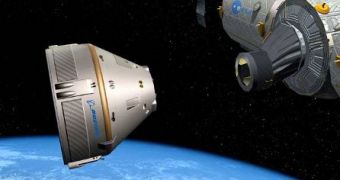Officials with the Boeing Company announce that they plan to start using their Commercial Space Transportation-100 (CST-100) manned space capsule to launch NASA astronauts to the International Space Station as early as 2015 or 2016.
While a firm date cannot yet be set, the company is convinced that it has what it takes to start operating the CST-100 within this relatively close time frame. Boeing is now developing a cargo version of this capsule, but is instead aiming directly for the manned version.
It is currently operating under a contract with NASA, which has retired its three-orbiter fleet back in mid-2011. Since then, the American space agency has been left without any means of reaching the ISS on its own spacecraft. It now depends on Russia for both manned and cargo flights.
Needless to say, NASA and Congress are not very comfortable with this, which is why they are funding several companies, including Boeing, in their effort to develop and test private spacecraft.
Boeing has already selected the Atlas 5 rocket as the delivery system for CST-100. The carrier vehicle is built by the United Launch Alliance (ULA), which is itself a joint venture between Boeing and Lockheed Martin, Space reports. Other rockets may also be used in the future.
In addition to the ISS, the new spacecraft will be able to target other destinations in low-Earth orbit as well. “It's been an interesting last couple of years for us,” the president of Boeing's network and space systems, Roger Krone, said last month.
“I think many people in the industry associate Boeing with the shuttle program and the International Space Station. [This is] kind of a chance for us to rethink what our space strategy is,” he went on to say.
An engineering version of the Boeing capsule has already been put through a series of assessments, including a parachute drop test, on April 3. The event took place at the Delamar Dry Lake Bed, near Alamo, Nevada.
“The CST-100 is set up to land in the desert on airbags. On this test, we dropped from a helicopter and checked the deployment and operation of three large chutes,” Elbon said, adding that a new drop test is scheduled to take place this May.
Boeing is developing the CST-100 so that it can carry seven astronauts, and be reusable for up to 10 times. At its widest, the spacecraft is 4.5 meters (14.8 feet) in diameter. “Its role is to provide affordable transportation to the space station so there's money left in the budget to develop beyond LEO capability,” Elbon concluded.

 14 DAY TRIAL //
14 DAY TRIAL //